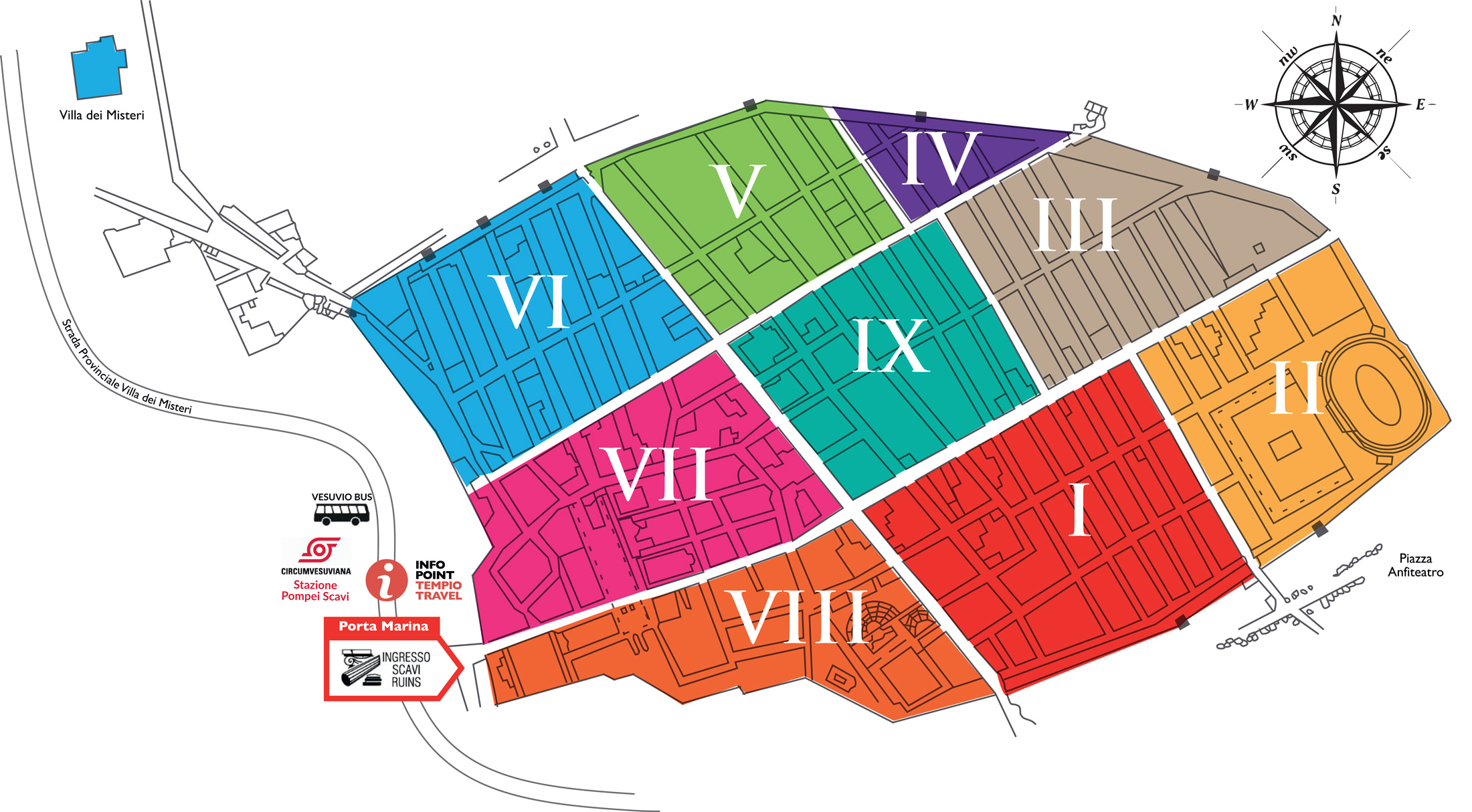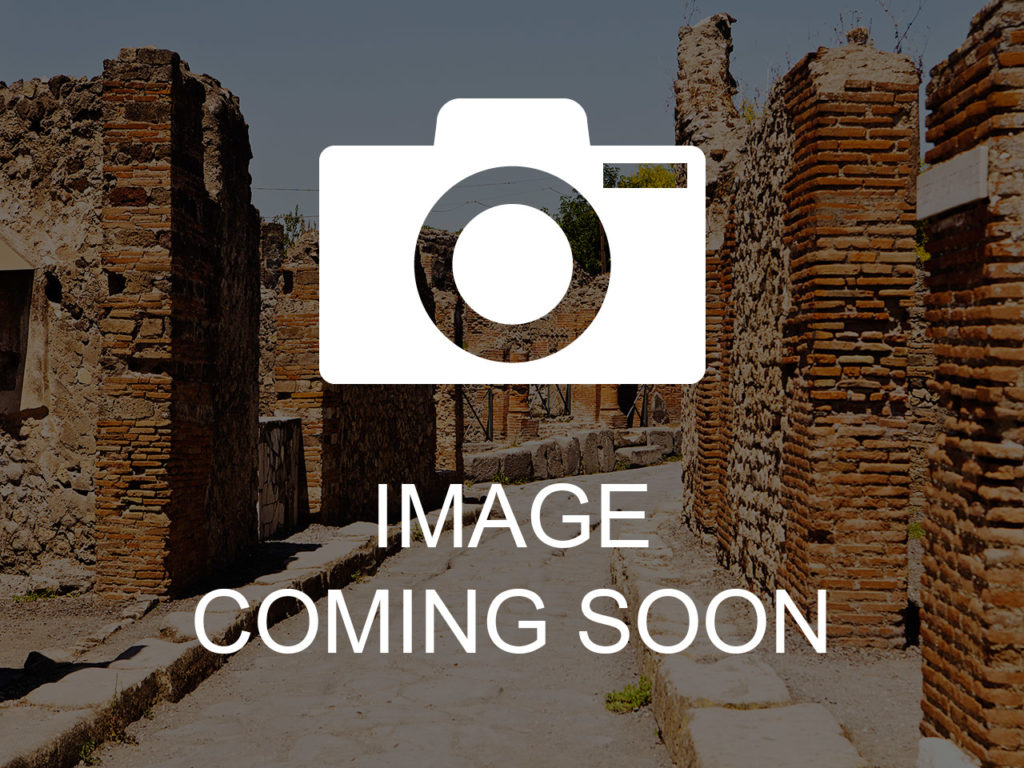Map

REGIO VII
REGIO I
REGIO II
REGIO III
REGIO IV
REGIO V
REGIO VI
REGIO VIII
REGIO IX
REGIO V
House of Lucretius Fronto
The house is situated in a side street on the Via di Nola, which has only been partly excavated. The house itself is small but very elegant, due to the refined third style decorations (or Egyptianizing style), considered to be superior to those found in Rome. The decorations in the tablinum depict landscapes with villas and gardens as well as two mythological paintings. The wall to the left illustrates the marriage of Venus and Mars while to the right we can see the Triumph of Bacchus accompanied by Ariadne on a carriage drawn by oxen. In the yellow room to the right of the tablinum, in addition to a group of cupids, a painting with Narcissus looking at his reflection in the water and Perona breastfeeding her old father, Myconis. In the center of the left wall in the winter triclinium there is an illustration of a scene taken from Euripides’ tragedy “Andromache”, in which Neottoleus is killed by the sword of Orestes on the altar of Apollo. In the next cubiculum there is a ‘triumph’ of extremely small and intricate details set against a black background, while on the right wall there is a painting of Ariadne bringing Theseus the thread so that he can find his way through the labyrinth. The house extends out towards the back garden, whose walls used to be covered in frescoes depicting hunts for wild beasts and other animals. The selection of mythological subjects, rich in functional artistic and literary references is used to emphasize the high cultural level of the owner.
House of Lucius Caecilius Iucundus
The rigorous portal made of tuff and the construction technique of the internal walls indicate that the house was originally built in the 2nd century BC, but underwent major restructuring and fine redecoration of all sections in the last period of life of the city, when the Caecilii family became the new owners. Caecilius was an important banker of Pompei, who probably got very rich by lending money to folk who had to repair their houses due to the earthquake in 62 d.C. His rich archives of 154 waxed boards carbonatized but still readable, have been found; leading the archeologist to reconstruct 10 years of his activity and to find out his economic status, selling land or slaves and payment receipts. A bronze portrait of the founder of the family was found in front of the tablinum and its currently exhibited at the National Archaeological Museum of Naples. The most famous findings of the house are however two marble reliefs (one stolen) which adorned the home chapel (lararium) of the atrium and represented the effects that the earthquake of 62 AD had on some public buildings in Pompeii. These artifacts where probably commissioned by Caecilius as an atonement for the angry Gods. The tablinum is decorated with mosaic floors and III style painting, including some famous mythological subjects, such as a Satyr touching the breast of a Menade and a representation of the body of Ettore after the battle. The peristyle is well preserved, with his marble fountains and erotic frescoes.
House of Lucius Caecilius Iucundus
The rigorous portal made of tuff and the construction technique of the internal walls indicate that the house was originally built in the 2nd century BC, but underwent major restructuring and fine redecoration of all sections in the last period of life of the city, when the Caecilii family became the new owners. Caecilius was an important banker of Pompei, who probably got very rich by lending money to folk who had to repair their houses due to the earthquake in 62 d.C. His rich archives of 154 waxed boards carbonatized but still readable, have been found; leading the archeologist to reconstruct 10 years of his activity and to find out his economic status, selling land or slaves and payment receipts. A bronze portrait of the founder of the family was found in front of the tablinum and its currently exhibited at the National Archaeological Museum of Naples. The most famous findings of the house are however two marble reliefs (one stolen) which adorned the home chapel (lararium) of the atrium and represented the effects that the earthquake of 62 AD had on some public buildings in Pompeii. These artifacts where probably commissioned by Caecilius as an atonement for the angry Gods. The tablinum is decorated with mosaic floors and III style painting, including some famous mythological subjects, such as a Satyr touching the breast of a Menade and a representation of the body of Ettore after the battle. The peristyle is well preserved, with his marble fountains and erotic frescoes.
House of the Silver wedding
The House house owes its name to the royal visit of Umberto I and Margherita of Savoy on their silver wedding anniversary in 1893. It’s the biggest house of the district and one of the street of the city is named by it. Until the most recent excavation of the city we only knew a little part of the district, the area was still filled with vulcanic materials. Nowadays the map can be modified because the archeologists have discovered the rest of street, a little square with a fountain, a caupona and some houses. All of these discoveries helped to understand a little better the context where the house was built, meanwhile a big restoration of the house is going on, hopefully for opening it back to the public soon. The impressive architecture of the house, with high Corinthian columns of tuff in the atrium, shows the importance of the owner, Lucius Albucius Celsus, a member of the local aristocracy. In addition there were two gardens: the first in line with the atrium, with a rhodium-type peristyle and its own private bath-house and open-air swimming pool; the latter decorated with mosaic floor and second style paintings with four octagonal imitation porphyry columns supporting a barrel-vaulted ceiling. The ceiling of the peristyle is higher on the side which receives most sunlight in order to provide a particularly pleasant area to sit on winter days. The second garden, which is much larger and completely surrounded by a wall, has a pool in the center and an outdoor triclinium.


